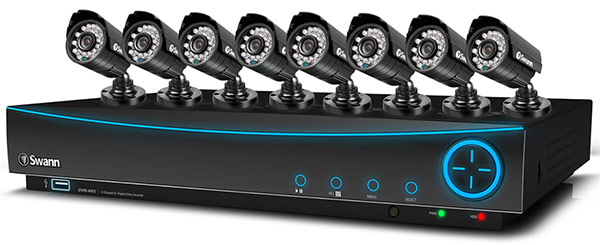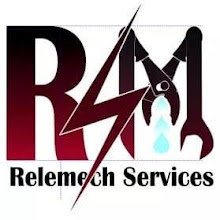If you have a surveillance camera system and you'd like to record and archive footage, you have a number of options at your disposal. As technology has moved from analogue to digital, older technologies have become obsolete or less efficient than their contemporary counterparts. Hopefully, this article will be able to inform you enough to choose the right recording method for your unique needs.
Digital Video Recorders (DVRs)
DVRs are an extremely popular way to store surveillance video. They have the capacity to store hours of footage and the ability to use motion detection to trigger recording. Not only will you have space for much more footage, your footage will also be more meaningful since you can set up your DVR not to activate recording until motion occurs in front of your camera.
 |
| A Digital Video Recorder |
Some DVRs can be connected to a network via Ethernet cables or Wi-Fi, allowing users to connect remotely and view the home’s cameras. Surveillance DVRs also come with a wide variety of channel options; one camera is attached per channel. Therefore, an eight channel DVR is capable of recording up to 8 video feeds at a single time. The downside is that the more channels being recorded, the less hours of continuous footage a DVR is capable of recording unless the DVR combines the various channels into one video recording feed.
Additionally, DVRs come in a wide array of sizes and functions. Some are battery powered and small enough to wear on a person’s body, making these devices ideal for personal mobile surveillance.
Recording to Your Computer
With large hard drives computers make decent video recorders, but with the following disadvantages.
First, digital video takes up a lot of storage space.
Second, in order to record and archive video through your computer, you’ll need to install dedicated software to manage the process. Many digital video cameras come with their own software packages but you can purchase dedicated, standalone software packages with more capabilities and more channels.
 |
| Securiy Surveillance Moitor |
Most video surveillance software enables motion detection to keep from recording unneeded video. The real difference in sophistication among software offerings lies in video archiving and management features. Some software offers cataloguing functionality that lets you label, manage and store your clips. Higher end software will also send you text or email alerts based on specific activity (when the camera detects motion, for example).
Cloud Recording
Over the last few years, “the cloud” (a catchy way to refer to storage of digital data by a third party on the Internet) has become an increasingly popular method to record and store surveillance video. There are several advantages to cloud storage, and only one downside.
 |
| Security Cloud Recording |
The pros: By recording, storing and backing up your footage in the cloud, you’ll know your video clips won’t be lost or deleted by accident -- and you won’t have to use up storage space on your computer or a standalone recording device. Even more important, cloud storage enables you to access your video from computers, tablets or smartphones no matter where you are, as long as you have an active Internet connection.
The cons: To get the convenience of cloud storage, you’ll usually have to pay a monthly fee to the service provider. The fee will vary based on the provider, the number of cameras in your system, the features available and other factors.
Memory Card Recorders
The cons: To get the convenience of cloud storage, you’ll usually have to pay a monthly fee to the service provider. The fee will vary based on the provider, the number of cameras in your system, the features available and other factors.
Memory Card Recorders
The most popular way to record from a single camera is with a memory card recorder. Like DVRs, memory card recorders can be set up to capture video only when motion is detected. However, the storage capacity is significantly lower and you can only use a memory card recorder with one camera at a time. Many cameras have built-in memory card video recorders, which is convenient because they don't require any external wires or wireless transmitters.
 |
| Security Surveillance Camera With A Micro SD Slot |
Memory card recorders are great for people who want the functionality of a DVR without the steep price, and only need to record footage from one camera at a time.
Portable Media Players (PMPs)
Portable Media Players (PMPs)
 |
| A Wireless Security Surveillance System |
The newest way to record and archive video is by using a portable media player. PMPs resemble iPods and have large LCD screens that allow you to view video. Since they are small enough to fit into your pocket, they're great to use with body-worn cameras. They lack motion detection recording capabilities and they're a bit on the expensive side, but their versatility can be worth it, especially for those who want to use the PMP for purposes other than recording surveillance.
NVR vs. PC-based Video Recording Solution
Video recording solutions in the IP surveillance systems come in two varieties, Network Video Recorders (NVR) and PC-based systems. Both these recording solutions provide a storage facility for the content captured by surveillance cameras; and take care of the functions of managing the cameras, recording content, viewing content, and archiving content. The differences between the two lie in how they operate and the features they provide.
Here is a comparison of the two recording solutions
Size
The stand-alone NVR comes with all the components in a single box, and is compact, while a PC-based system is built around a general-purpose desktop/notebook and comes with a separate CPU, keyboard, a USB mouse and monitor. Thus, a stand-alone NVR occupies less shelf-space while performing similar functions.
Storage
Although NVRs have ample internal recording and storing space, the PC-based systems offer as much as seven times more storage, when compared to an NVR. This advantage is, however, addressed by NVRs, through the provision for external storage options (USB storage devices, eSATA devices, Firewire storage devices, NAS appliances, etc.)
Stability
The NVR is extremely stable and reliable since it contains fewer components. The software is often written in basic machine code or Linux code and is designed to run only one application. This tends to make the NVR more stable when compared to a PC-based system running a Windows application.
Boot Time
The NVR runs an embedded operating system as compared to a PC-based system, which needs to run an application under the Windows OS before it begins recording. This means that the NVR will start faster as compared to the PC-based system; which will take longer to load.
Security
The stand-alone NVR comes with all the components in a single box, and is compact, while a PC-based system is built around a general-purpose desktop/notebook and comes with a separate CPU, keyboard, a USB mouse and monitor. Thus, a stand-alone NVR occupies less shelf-space while performing similar functions.
Storage
Although NVRs have ample internal recording and storing space, the PC-based systems offer as much as seven times more storage, when compared to an NVR. This advantage is, however, addressed by NVRs, through the provision for external storage options (USB storage devices, eSATA devices, Firewire storage devices, NAS appliances, etc.)
Stability
The NVR is extremely stable and reliable since it contains fewer components. The software is often written in basic machine code or Linux code and is designed to run only one application. This tends to make the NVR more stable when compared to a PC-based system running a Windows application.
Boot Time
The NVR runs an embedded operating system as compared to a PC-based system, which needs to run an application under the Windows OS before it begins recording. This means that the NVR will start faster as compared to the PC-based system; which will take longer to load.
Security
Both NVRs and PC-based systems can connect directly to the network (LAN/WAN). The NVR is optimised for video recording and viewing, and is stripped off software components and modules that do not assist in these functions. A PC-based system is dedicated as well, but on account of the non-optimised nature of the OS and attendant applications, is open to the standard problems a user may encounter in a network; like virus attacks, hacking, etc.
Performance
Performance
On account of the function-specific processors that NVRs are typically built around, NVRs offer a performance advantage over PC-based systems. PCs use the CPU for video compression/decompression, viewing and recording content, and managing cameras; while an NVR usually has one or more DSPs for video compression/decompression, and a CPU (albeit less powerful than its PC-based system counterpart) for the other functions. Obviously, a PC-based system with a very powerful CPU and oodles of RAM can match the performance of an NVR; but, such a system is going to be more expensive.
Scalability
Scalability
An NVR is designed to offer optimal performance for a set number of cameras, and is normally less scalable than a PC-based system. This makes the unit suitable for smaller systems where the number of cameras stays within the limits of an NVR’s designed capacity.











